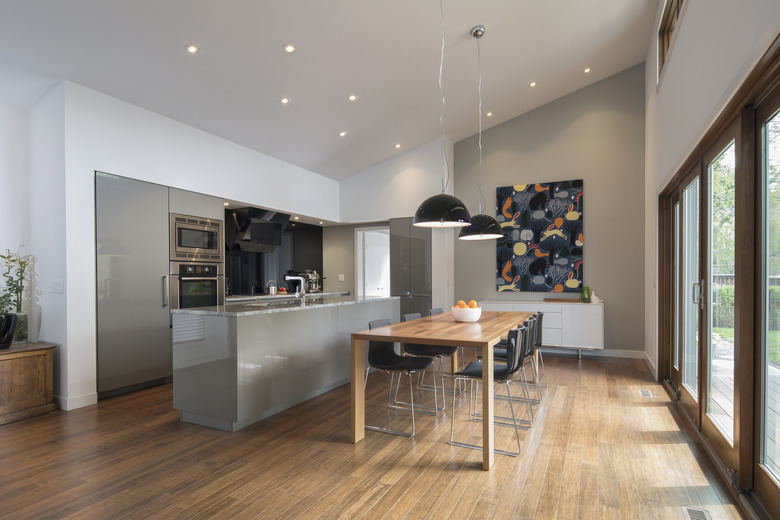What Can I Do To Keep Furniture From Moving On Laminate Flooring?
Laminate and wood floors share a common trait when it comes to furniture: It's sometimes difficult to keep furniture from sliding on the floor. If your dining room table and chairs never seem to stay centered beneath the chandelier, it's due to sliding furniture. Thankfully, the issue is easily resolved with various types of furniture grippers or an area rug.
Peel-and-Stick Grips
Peel-and-Stick Grips
Peel-and-stick furniture grips are one of the best hacks to keep furniture from sliding. This type of pad sticks to the bottom of chair, sofa and table legs, preventing the objects from slipping. These pads stick atop the existing plastic nub used at the bottom of many types of furniture legs. Simply measure the diameter or width of the existing nub on the furniture leg, then purchase a set of peel-and-stick grips in a similar size.
Purchase enough grips to use for all the table and chair legs, plus a few extra. Over time, the sticky coating may wear off of the grips. If multiple furniture items slide on the floor, purchase grips in the largest size needed. Trim these to fit the smaller chair leg nubs or feet.
Furniture Grippers for Hardwood Floors
Furniture Grippers for Hardwood Floors
Any type of furniture gripper designed for hardwood floors also works on laminate floors. Some of these will even stop furniture from sliding on carpet. A rubbery furniture grip that uses no adhesives or fasteners is a perfect option for furniture that's rarely moved, such as tables, armchairs and sofas. These aren't the best choice for dining chairs, however, as they're not permanently affixed to the chair legs.
These loose furniture grippers have a texture on one side to grip the bottom of the chair leg, plus a gripping rubbery surface on the bottom side to cling to the floor. To size these, purchase them slightly larger than the bottom of the furniture leg or the attached leveler, nub or foot on the bottom. Set one directly beneath each leg. If they're too obvious, trim them a little closer to the size of the leg.
Homemade Furniture Grips
Homemade Furniture Grips
Making your own furniture grippers is another way to prevent furniture pieces from sliding. Purchase a sheet of rubbery nonslip shelf liner, then cut it into squares the width of the furniture leg. Layer several together under each furniture leg. As with other grippers that don't adhere to furniture legs, this method is best for items that should stay put, such as the couch and end tables.
Cup Style Grips and Caps
Cup Style Grips and Caps
Furniture without protective plastic feet or nubs at the ends of the legs may scratch laminate flooring. Dining chairs, in particular, can be problematic since they're moved regularly. Slip-on caps that go onto the ends of the furniture legs can help prevent scratching; choose a rubber version to ensure they won't slide, either.
Cup-style rubber grips that come in square or round shapes are also an option. Purchase these with a center indentation large enough to fit the bottom of the furniture leg. Once again, look for a nonslip variety rather than a hard plastic piece that will slide on the floor. The downside to both slip-on caps and cup-style grips is they're more visible than gripping pads cut to fit beneath the furniture legs.
Use an Area Rug
Use an Area Rug
An area rug that has a pad safe for laminate and wood floors also helps keep furniture from slipping. For a living room, consider placing one end of the area rug beneath the front legs of a sofa, for instance. Side chairs can sit elsewhere around the perimeter of the rug. In the dining room, an area rug should be large enough to hold the entire dining table and at least some of the legs on each chair when the chairs are in use.
